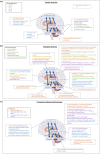Structural magnetic resonance imaging in dystonia: A systematic review of methodological approaches and findings
- PMID: 35785410
- PMCID: PMC9796340
- DOI: 10.1111/ene.15483
Structural magnetic resonance imaging in dystonia: A systematic review of methodological approaches and findings
Abstract
Background and purpose: Structural magnetic resonance techniques have been widely applied in neurological disorders to better understand tissue changes, probing characteristics such as volume, iron deposition and diffusion. Dystonia is a hyperkinetic movement disorder, resulting in abnormal postures and pain. Its pathophysiology is poorly understood, with normal routine clinical imaging in idiopathic forms. More advanced tools provide an opportunity to identify smaller scale structural changes which may underpin pathophysiology. This review aims to provide an overview of methodological approaches undertaken in structural brain imaging of dystonia cohorts, and to identify commonly identified pathways, networks or regions that are implicated in pathogenesis.
Methods: Structural magnetic resonance imaging studies of idiopathic and genetic forms of dystonia were systematically reviewed. Adhering to strict inclusion and exclusion criteria, PubMed and Embase databases were searched up to January 2022, with studies reviewed for methodological quality and key findings.
Results: Seventy-seven studies were included, involving 1945 participants. The majority of studies employed diffusion tensor imaging (DTI) (n = 45) or volumetric analyses (n = 37), with frequently implicated areas of abnormality in the brainstem, cerebellum, basal ganglia and sensorimotor cortex and their interconnecting white matter pathways. Genotypic and motor phenotypic variation emerged, for example fewer cerebello-thalamic tractography streamlines in genetic forms than idiopathic and higher grey matter volumes in task-specific than non-task-specific dystonias.
Discussion: Work to date suggests microstructural brain changes in those diagnosed with dystonia, although the underlying nature of these changes remains undetermined. Employment of techniques such as multiple diffusion weightings or multi-exponential relaxometry has the potential to enhance understanding of these differences.
Keywords: MRI; diffusion MRI; dystonia; movement disorders; systematic review.
© 2022 The Authors. European Journal of Neurology published by John Wiley & Sons Ltd on behalf of European Academy of Neurology.
Conflict of interest statement
No conflict of interest to declare.
Figures




References
-
- Zoons E, Booij J, Nederveen AJ, Dijk JM, Tijssen MA. Structural, functional and molecular imaging of the brain in primary focal dystonia—a review. Neuroimage. 2011;56(3):1011‐1020. - PubMed
Publication types
MeSH terms
Substances
Grants and funding
LinkOut - more resources
Full Text Sources
Medical

